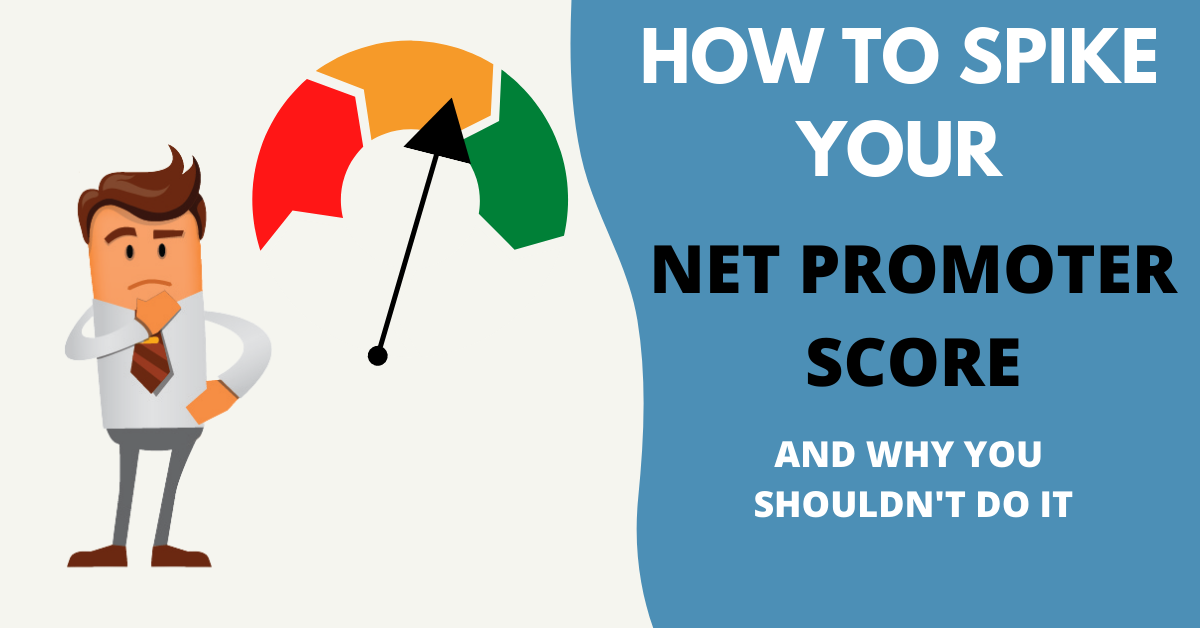People are often asking us to change the way Net Promoter Score is presented in surveys in order to get a higher score. I will show you three ways that work and then I will explain why it is a bad idea.
Before we start, here is a classic NPS question:
3 artificial (and wrong) ways to raise your NPS
So, in order from smallest to largest positive effect, here are three small changes that get you a higher NPS with no effort and no real benefit:
- Change the wording of the question slightly by adding “If asked,” in front of the question. A classic NPS question inquires if a respondent would out of themselves recommend a company or product. Adding “if asked”, ever so gently lowers the bar for the respondent pushing their score higher.
- Weaken the wording of end-points. Instead of “not at all likely”, use just “probably not”. Instead of “extremely likely”, use “likely”. Small difference, but a boost in score will follow.
- And last but not least, this change will have a very large impact on your NPS… colorize the answer scale. Color 0 through 6 in a gradient of red, 7 and 8 shades of orange and 9 and 10 green.
Why it is a bad idea to implement any of the above points
In some ways, Net Promoter Score is a victim of its own success. Business people love simple metrics and NPS is super easy to understand. There is a lot of pressure to have a higher NPS. That is why you see people in Europe grasping for their own lighter EU NPS, which we were once for but now against; that is a different article. Often bonuses depend upon someone’s NPS, so the temptation is great…
… yet it is a horrible idea to actually game your NPS! Yes, your score will go up, but not in any meaningful way. Sometimes, I am surprised by the amount of effort that people will expend in trying to get us to change the way we ask NPS questions on our survey platform. That effort should be spent on other aspects of NPS projects that have a high ROI, like follow-up.
A well run NPS project starts by asking the correct NPS question and getting a baseline reference score. Start plotting your NPS on a timeline.
Next, see NPS as a triage mechanism. The goal is to discover why detractors are giving you low scores and get that information deep into your organization to affect changes so that other customers do not have the same experience.
Often forgotten, but just as important, is to find out what experiences promoters are having and try to replicate those experiences for all of your customers.
A goldmine of information can be found in the open answers of respondents, also known as verbatims. You should be applying text analysis to reveal the gems found in them. Use ‘Net Sentiment Score (NSS)’ to quantify the results and plot those on a timeline too. Changes in sentiment should trigger action.
Issue management and follow-up are important and we cover them elsewhere.
As you can see, an effective Net Promoter program that actually improves your internal processes and actually makes your customers more loyal and happy takes effort and has the highest ROI. Don’t waste energy trying to game your score… It isn’t worth it.



1 comment
Join the conversationChristopher Brooks - March, 2020
Thanks for sharing. It’s systematic of a society focussed on targets. So, it get’s gamed (as do other metrics).
Clearly that is not right. But there are many CX practices which are not ‘purely’ delivered as well. The education of NPS for one. The text verbatim is as useless as the score data if it doesn’t correlate to what drives customer behaviour change for instance. It’s an unregulated discipline, with still just a few commercially backed training / certifications. Nothing Chartered, no real accountability of advisers or deep learning driven from academic qualifications yet. But it will come.
So articles like this are very helpful to inform